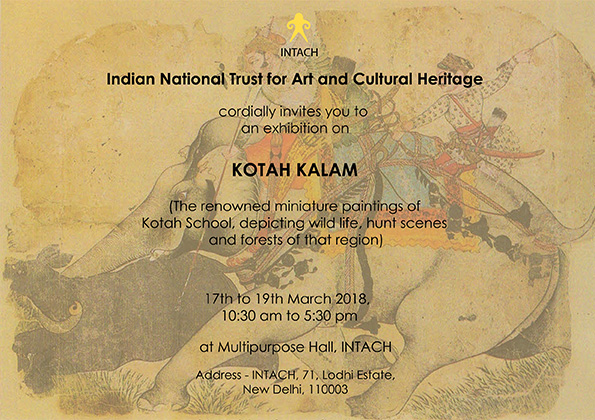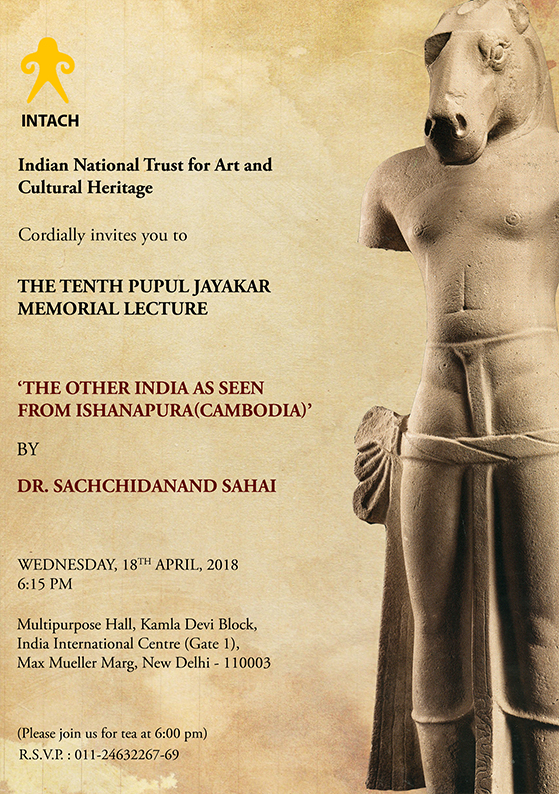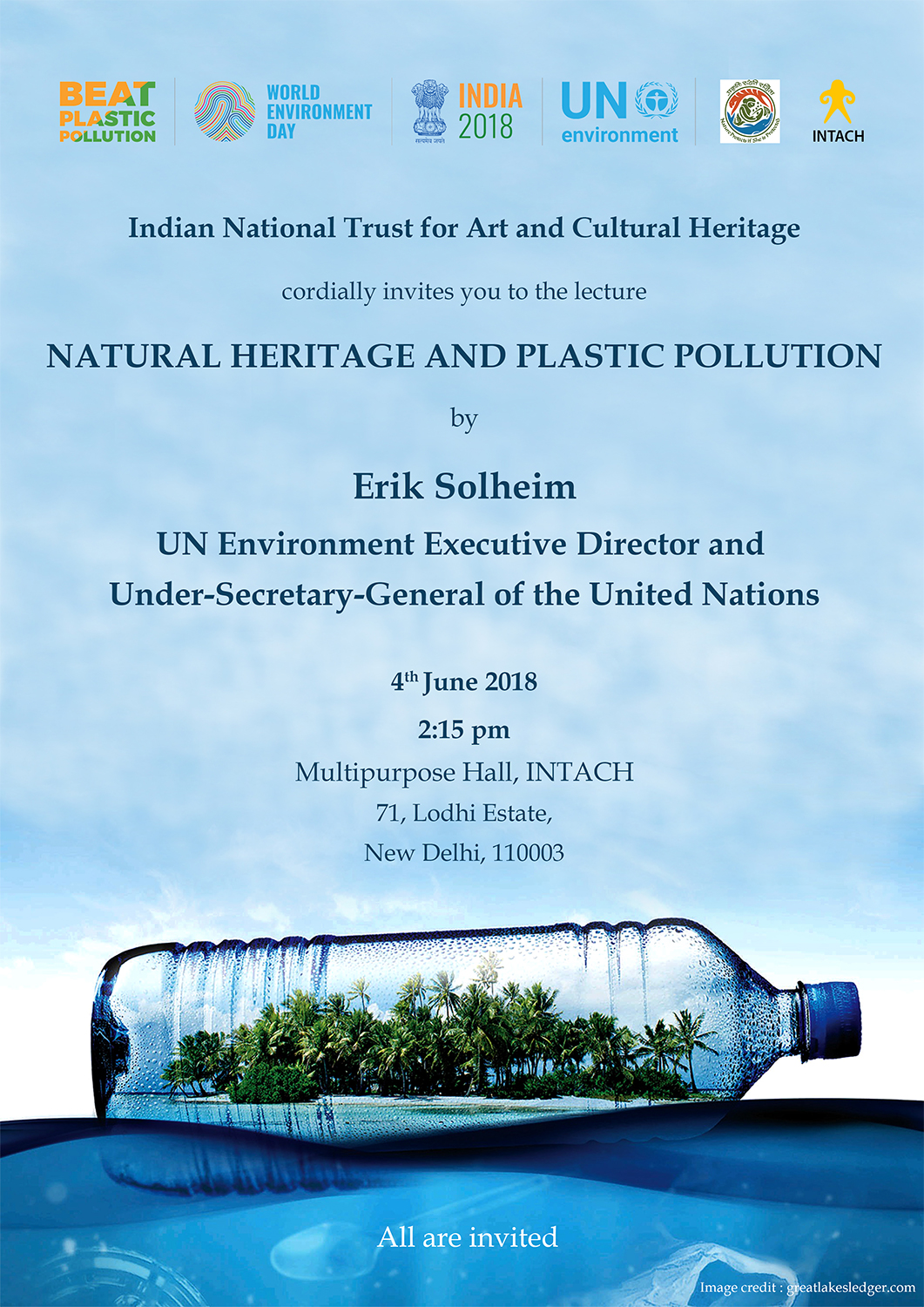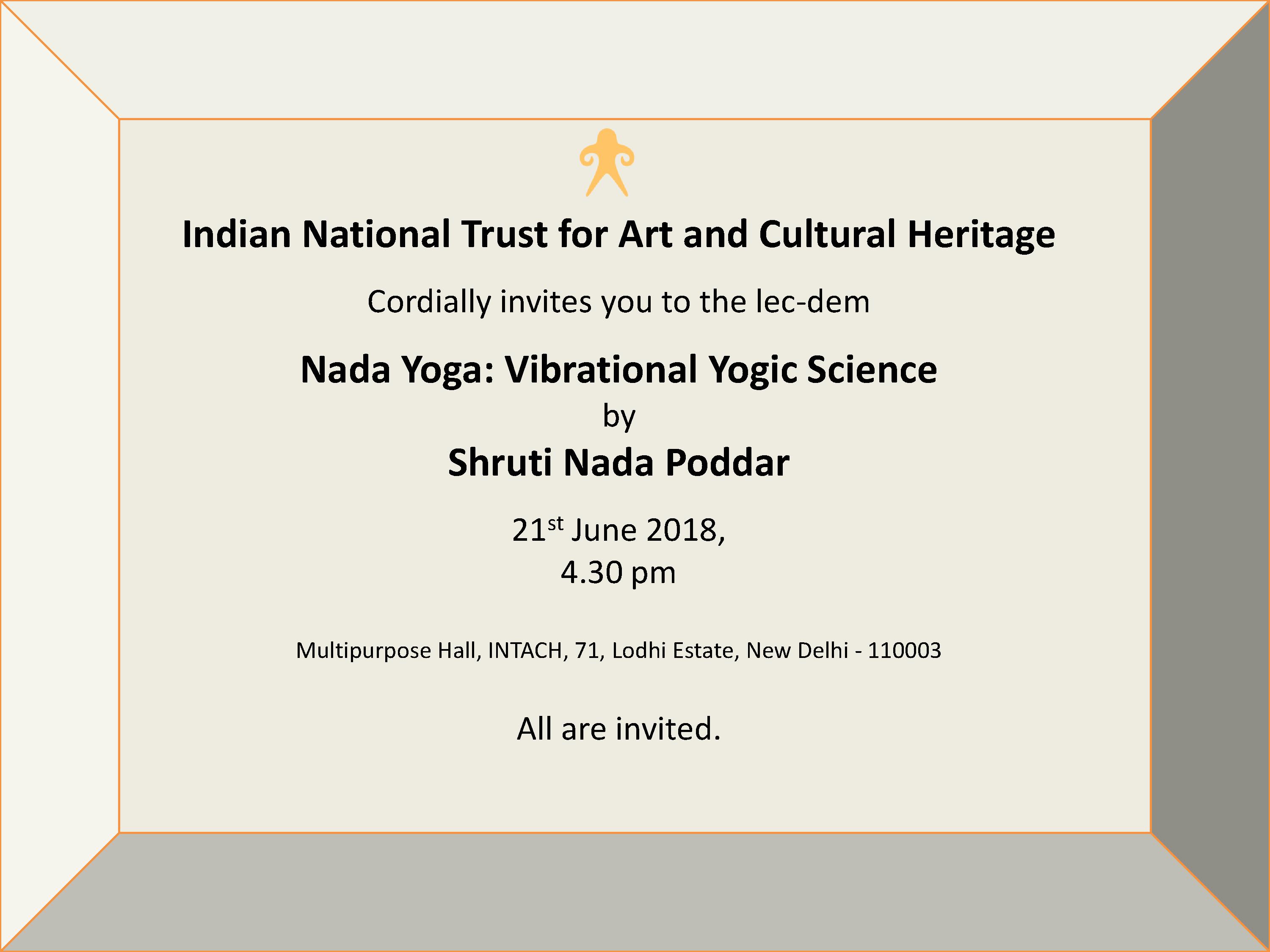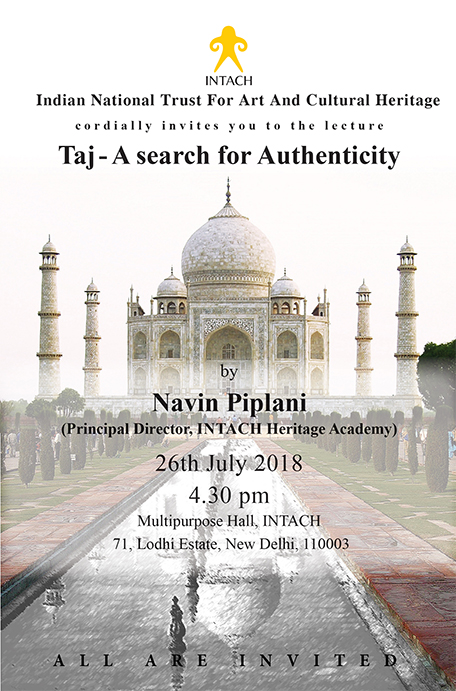Events Archives
-
Painting Exhibition: Kotah Kalam by artists from Kota
Date: 17 – 19 March 2018
Time: 10.30am – 5.30pm
Location: Multipurpose Hall, INTACH, New DelhiAn invitation to an exhibition on ‘Kota Miniatures’ is to be held for three days at INTACH from 17th to 19th March 2018. The renowned miniature paintings of Kotah School, depicting wild life, hunt scenes and forests of that region.
-
The Tenth Pupul Jayakar Memorial Lecture
‘The other India as seen from Ishanapura (Cambodia)’ by Professor Sachchidanand Sahai
Date: 18th April 2018
Time: 6.15pm
Location: Multipurpose Hall, India International Centre, Max Mueller Marg, New DelhiIt is our pleasure to invite you to the lecture, which will critically examine prevailing populist, ideas which claim to define India as a post-1947 product, without going into the cultural roots of Indian entity. India was shaped, in all its contours, by the ideals of a pluralistic society, as early as the third century BC.
Over and above, India as a model of pluralistic socio-economic and cultural entity was replicated in the Far-Eastern countries beyond the Ganga. As an actual example of this process, the lecture will lead you to the rediscovery of Ishanapura, a seventh century- temple city in central Cambodia, now a world-heritage site in the UNESCO list.
Prof. Sachchidanand Sahai is an alumni of Banaras Hindu University having obtained his M.A. in Ancient Indian History, Culture and Archaeology. Thereafter, he researched at the University of Paris, Sorbonne (1965-69). His post-doctoral research was at Cornell University, Ithaca, New York (1982).
Prof. Sahai has carried out extensive field work in Southeast Asia and has held the Chair of Southeast Asian Studies at the Magadh University, Bodh Gaya (India) and worked as the Pro-Vice Chancellor of the university in 2001. He has also worked as Fellow, Indian Institute of Advanced Study, Shimla (2003-2006); Research Professor at Indira Gandhi National Center for the Arts, New Delhi (1988-90); and Visiting Professor of Asian Civilization at Sisavangvong University, Vientiane (1970-73). Prof. Sahai was also National Professor of Epigraphy, Ministry of Culture, Government of India, New Delhi.
He has authored over 17 books, edited half a dozen books and has written forty research papers in various scientific journals. His five monumental volumes on the Ramayana of Laos, monographs on Angkor and Preah Vihear, publication on Political Institutions of Ancient Cambodia in French (EFEO, Paris) are some of his path breaking publications.
In 2012, he was awarded the Padma Shri for his contribution to the understanding of India’s cultural relations with neighboring Asian countries.
Professor Sahai is currently Adviser to Preah Vihear National Authority and APSARA National Authority (Angkor, Cambodia) under the auspices of the Royal Government of Cambodia.
-
Lecture on ‘Braj – Creating a Cultural Landscape for Bhakti’ by Divay Gupta
Date: 18th May 2018
Time: 4.30pm
Location: Multipurpose Hall, INTACH, New DelhiIt gives us great pleasure to invite you to the lecture on the region of Braj, which is bound together by the legends of Krishna. Within this context the town of Mathura, at the centre of Braj, is considered the birthplace of Krishna. However, the historicity of Braj goes beyond its popular association with Krishna. For more than 3000 years, it has been a seat of art, learning and religion. Jainism, Buddhism, Hinduism and Islam have all impacted the cultural development of the region. The geographical location – in the middle of Ganga-Yamuna doab, made it extremely fertile and productive and contributed to it becoming a nodal point of various trade routes passing through it. In the 16th century it became a centre of Bhakti movement, re-emphasizing the importance of the areas as Janmabhoomi & Leela Kshetra of Krishna. Thus, Braj was established as a major pilgrimage destination for Vaishnavites between the twin Mughal capitals of Delhi & Agra. Myths, legends, history and stories all intermix and co-exist here; their symbiotic and symbolic relationship determines the cultural landscape of the region, giving Braj its unique distinction.
The lecture will elaborate how within this region an entire cultural landscape was first imagined and then created over the last 500years, almost exclusively for celebrating Krishna Leela and how it evolved over the centuries and is under transformation today.
Divay Gupta is a leading conservation architect and heads the Architectural Heritage Division of INTACH. An Alumnus of ICCROM, University of Birmingham & School of Planning & Architecture, he has been striving for better management and conservation of the cultural resources in the country for more than 20 years. He has been a part of a number of prestigious conservation projects in India, Nepal and Cambodia and has participated in joint UNESCO & ICOMOS missions to World Heritage Sites as a conservation expert. His restoration projects in Ladakh have won the SA UNESCO awards of Merit & Excellence. He travels regularly for special lectures and being part of juries at various national and international conferences, seminars and colleges of architecture across India. He is a visiting faculty and a member board of studies, Department of Architecture Conservation at SPA New Delhi.
-
World Environment Day
Lecture on ‘Natural Heritage and Plastic Pollution’ by Erik Solheim
Date: 4th June 2018
Time: 2.15pm
Location: Multipurpose Hall, INTACH, New DelhiIt gives us great pleasure to invite you to the lecture on natural heritage. India has a number of natural heritage sites spread across the breadth of the country. Due to the fact that a lot of these sites are unprotected, they are vandalized, encroached upon and start systematically degrading. The INTACH charter focuses among other things on symbiotic relationships with the natural environment within which these sites are located and focuses on interdependent ecological conservation.
In order to draw attention to the menace of plastic littering in Natural Heritage sites, Erik Solheim will speak on the impact this has and what policy initiatives are required to mitigate the environmental hazard this littering poses.
Mr. Erik Solheim is the Under-Secretary-General of the United Nations and Executive Director UN Environment. Prior to joining UNEP, Solheim was the Chair of the Development Assistance Committee (DAC) of the Organization for Economic Co-operation and Development (OECD).
From 2007 to 2012, Mr. Solheim held the combined portfolio of Norway’s Minister of the Environment and International Development, and from 2005 to 2007 served as Minister of International Development. This unique portfolio mix allowed him to bring a coherent approach to development and the environment.
During his time as Minister, Norwegian aid reached 1 percent, the highest in the world. He also put in place the Nature Diversity Act, which many consider to be Norway’s most important piece of environmental legislation in the last 100 years. The Norwegian Climate and Forest Initiative provided critical input to the establishment of UN-REDD, the global coalition to reduce emissions from deforestation and forest degradation in developing countries.
Mr. Solheim is also an experienced peace negotiator, having acted as the main facilitator of the peace process in Sri Lanka from 1998 to 2005. The peace process led to a ceasefire and the Oslo Declaration in 2002. He continued to lead peace efforts in Sri Lanka as Minister and has contributed to peace processes in Sudan, Nepal, Myanmar and Burundi.
In addition to his career as a Minister and at the OECD, he has served as UN Environment’s Special Envoy for Environment, Conflict and Disaster since 2013 and as a Patron of Nature for the International Union for the Conservation of Nature (IUCN) since 2012. He has also received a number of awards for his work on climate and the environment, including UN Environment’s Champions of the Earth award and TIME Magazine’s Hero of the Environment.
-
International Yoga Day
Lec-Dem on Nada Yoga: Vibrational Yogic Science by Dr. Shruti Nada Poddar
Date: 21st June 2018
Time: 4.30pm
Location: Multipurpose Hall, INTACH, New DelhiIt gives us great pleasure to invite you to a lec-dem on Nada Yoga. Nada is the body of vibrations, waves, frequencies and harmonies within everything that exists. It is experienced by us and influences us at all times, often unknown to us. Nada Yoga which has been used in almost every Indic spiritual and wellness practice through time offers powerful Nada (vibrational) techniques and remedies. The experiential talk and lec-dem on Nada Yoga on International Yoga day will highlight and teach the audience some tools for self healing.
Dr. Shruti Nada Poddar is a pioneer of the NADA VIBRONICS– a Nada Yogic Wellness Ecosystem based on Indic Vibrational Yogic Science. She has taught and influenced 15000 teachers in integral education. She regularly gives talks and conducts workshops on various subjects ranging from leadership through Vedas, Upanishads and the Bhagawadgita to scientific explorations of music and ancient Indian sound for cure of diseases.
Shruti Poddar founded the Shruti Foundation in 2007, a research and charitable foundation for promoting education, wellness and healthcare, value based leadership and advocacy with a special focus on indigenous knowledge systems and science.
Dr. Shruti Poddar is the Convener of INTACH for three districts of Rajasthan, Sikar, Churu and Jhunjhunu.
-
Lecture on ‘Taj – A Search for Authenticity’ by Navin Piplani
Date: 26th July 2018
Time: 4.30 pm
Location: Multipurpose Hall, INTACH, New DelhiIt gives us great pleasure to invite you to the lecture. The Taj Mahal, commonly known as one of the Seven Wonders of the World, is a monument synonymous with divine beauty. Architecturally it has perfect proportions and tourists from around the globe visit it as once a lifetime experience. Reams have been written about it by scholars and a thousand cameras have clicked its iconic image. It has been the subject of many paintings and its story of the love of a Mughal Emperor for his beloved wife, captured in stone for eternity, is now engraved in history. Indeed it is a monument that has no parallel in the world.
The lecture will explore the many facets of the Taj Mahal as an architectural marvel, a mausoleum, a tourist destination, the heritage of the world and a symbol of love. The various efforts for its conservation and preservation will also be discussed in the light of natural and man-made forces. It will deconstruct the prevalent notions of ‘what the Taj is?’ and help re-imagine the authentic experience of the site.
Navin Piplani is a Conservation Architect and a former Director of Studies and Hamlyn Feilden Fellow, Centre for Conservation Studies, The University of York, United Kingdom. Currently, he is the Principal Director, INTACH Heritage Academy, New Delhi.
Since 2002, Navin has worked as a core member of the Taj Mahal Conservation Collaborative, as part of a multi-disciplinary team of heritage professionals, engaged in the conservation of the World Heritage Site of Taj Mahal. In 2004, Navin assisted Professor A.G. Krishna Menon, an eminent conservationist, for the preparation of the INTACH Charter for the Conservation of Unprotected Architectural Heritage and Sites in India. He has lectured at several academic institutions and professional organizations in India and abroad and has worked on a range of conservation projects in India and Europe.
Navin is a Vice President of ICOMOS (International Council on Monuments and Sites) International Training Committee (CIF) and former National Scientific Councilor of ICOMOS India. He was appointed as an expert member from Asia-Pacific on the ICOMOS World Heritage Panel 2017-18, which is the apex body of international experts for the evaluation of and recommendation on nominations to the UNESCO World Heritage Committee. He has researched and published widely on heritage conservation education, training and capacity building.



